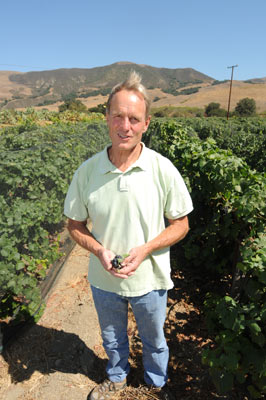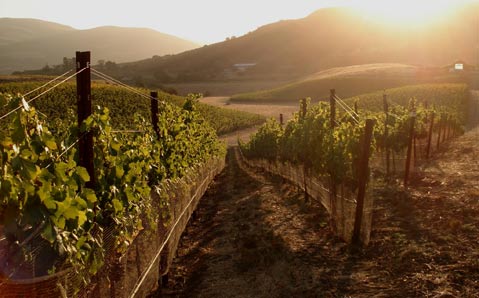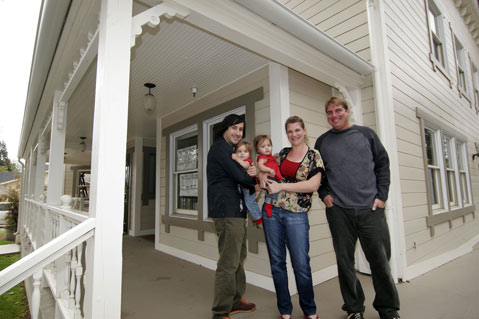Tasting with Director of Wine: The Green Revolution
Thursday Afternoon SBIFF Screening Leads to Friday of Tasting with French Director Guillaume Bodin

Though punctuated by celebrity sightings, swanky parties, and full days of film watching, what really makes SBIFF a special time to be in Santa Barbara is the vibrant energy that comes from a truly international gathering of creative types who choose to mingle on our streets for a few days out of the year. On any given day, you might run into a documentarian from Russia, a director from Cambodia, and a surf filmmaker from Chile, all eager to chat about their work and what they’ve seen during the fest so far. As you’d imagine, this sort of milieu lends itself to unique opportunities to explore and enjoy life a little deeper, whether it’s by simply showing off the county courthouse to someone from out of state or embarking on a quick adventure in search of experiences that transcend borders.
Such was what happened this past Thursday afternoon, when I went to a screening of Wine: The Green Revolution, or as it’s known in French, La Clef des Terroirs. A solid first-effort documentary by a 25-year-old French winemaker-turned-filmmaker named Guillaume Bodin, the feature-length film explores how the agricultural practice of biodynamics has overtaken many vineyards throughout France, and features interviews with such prominent people as Aubert de Villaine from Domaine de la Romanée Conti, which is considered the best winery in the world.
Following the film, Bodin was asked a few questions by SBIFF head honcho Roger Durling, who knows I am a fan of wine and spotted me in the second row. When it was over, Durling pulled me aside to reveal that Bodin had brought a couple bottles from France, and that I should join them to celebrate the film’s screening. A few minutes later at the Rosebud Lounge — the transformed party spot behind the Lobero Theatre — Durling, Bodin, SBIFF president Doug Stone, and I were huddled on the side of the room, sipping on vibrant Burgundian chardonnay and some racy cabernet franc from a lesser known region.

I asked Bodin whether he was planning to visit our wine country, where a handful of biodynamic growers and many more organic growers are making great wine. “No,” he said in his French-inflected English, “I don’t have the time.” A few questions later, I realized that he had the time, but not the means, like a car or a guide, and my duty became clear.
“No way — I’m not letting you come all the way to Santa Barbara and not see our wine region,” I said, offering to drive him around wine country the next morning, and starting to make a series of phone calls, text messages, and emails to see what I could set up.
At 8:30 a.m. on Friday, I picked Bodin up in front of the Hotel Santa Barbara, and we were off to wine country. As we drove up the Gaviota Coast, I described the layout of the county’s wine growing region, slipping from the cool and foggy Sta. Rita Hills, home to pinots and chardonnays, eastward toward Happy Canyon, our newest appellation where hotter days make for better cabernets and other Bordeaux varietals. The Channel Islands were crystal clear, so I gave him the rundown on them, and soon realized that I had way more information than we had time to go through. (In related news, check out my New York Times article on Santa Rosa Island here.)
Despite not hearing back from anyone, I decided that our first stop would be Alma Rosa Winery, home to Sta. Rita Hills pioneer and longtime organic advocate Richard Sanford. It was a fitting place to start, since Santa Barbara’s modern winemaking era pretty much began there anyway, and I gave him the legendary story of Sanford driving around the region with a thermometer outside of his window to find the perfect place for growing pinot. He wasn’t there yet, but thanks to a very helpful wine club manager we tasted through their offerings. (As is common practice for those who interact with wine professionally, we spit out our samples each time, so there was no worries about drinking and driving or, perhaps more problematic for our purposes, not being able to taste the next wine.) Immediately, Bodin — who like most Frenchman, tend to believe that wine can only be made perfectly in his homeland — had his eyes opened. The chardonnay wasn’t buttery, as he feared, and the pinot noirs were nicely acidic, even bitter, a flavor that many French wineries are striving for.
After he selected a pinot to take home, Richard Sanford arrived, and we sat down in his office for a few minutes, with Bodin and Sanford chatting about mutual friends in France, of which they had many, although Bodin tended to know the younger generation and Sanford their parents. Visibly pleased with having met one of the few American winemakers he’d heard of — on that note, Sanford will be inducted into the winemaking hall of fame up in Napa later this month — Bodin and Sanford posed for a picture together, and we hit the pavement of Santa Rosa Road toward Lompoc.

Like almost anyone who visits for the first time, Bodin was a bit surprised by the industrial layout of the Lompoc Wine Ghetto, a collection of garages where more than one dozen winemakers have set up shop. After almost bugging Richard Longoria (who I think I spotted inside his winery), trying our luck at Jalama Wines (whose syrahs impressed me mightily a few weeks back), or heading into EveningLand (which is one of the most buzzed about wineries in the country right now), we opted for Ampelos Cellars, which was the first place I had called the night before, having been introduced to biodynamics during a tour of Peter and Rebecca Work’s vineyard a few years ago.
Inside was assistant winemaker/carpenter/tasting room host Tanner, who took us through their offerings, from the Chien gruner veltliner through the pinots and onto the Syrache, grenache, and syrah. Originally from Colorado, he could speak a pretty good game of biodynamics and proved intimately knowledgeable about everything in the vineyard and winery. Bodin and he traded theories and opinions on biodynamics, and then Bodin purchased a pinot and the Syrache.

From there, we drove back on Highway 246 through Buellton and Solvang (whose Danish theme made Bodin laugh a little, though I defended its legitimate origins), and went up Alamo Pintado Road to Los Olivos, where we walked into Qupe’s tasting room to find Ethan Lindquist pouring his dad’s wines as well as his own eponymous brand and his stepmom’s Verdad label. I decided to purchase a couple bottles there, a Qupe grenache and one of the last remaining Ethan grenaches, and then it was off to Cold Spring Tavern for a lunch of chili for Bodin, a deer sausage burger for me, and Figueroa Mountain Brewery’s Danish Red Lager for both of us. After explaining that he’d wished to do exactly what we did that day, but didn’t know how to arrange it when he was setting up his first trip to California, Bodin graciously picked up the tab.
We were back in town by 2:30 p.m., Bodin off to drop his bottles and check out a screening, me to the office to handle a mess of emails and more SBIFF coverage. It was a morning and afternoon that we’ll probably both remember for the rest of our lives, a chance encounter only made possible by SBIFF. And now I have a friend in Burgundy who can do the same for me.
411
Wine: The Green Revolution screens for the last time on Sunday, February 5, 4 p.m., at the Santa Barbara Museum of Art. See laclefdesterroirs.com for more info.
To learn more about the places we encountered on our road trip, see:
* qupe.com



